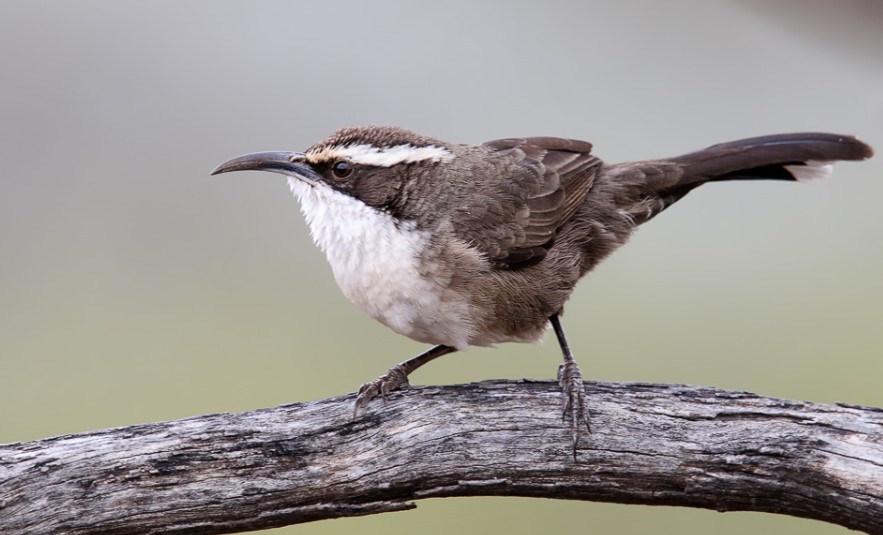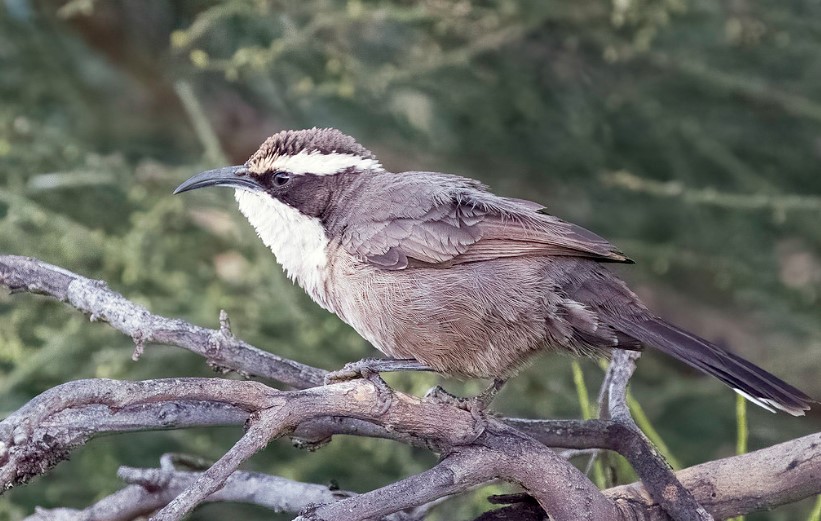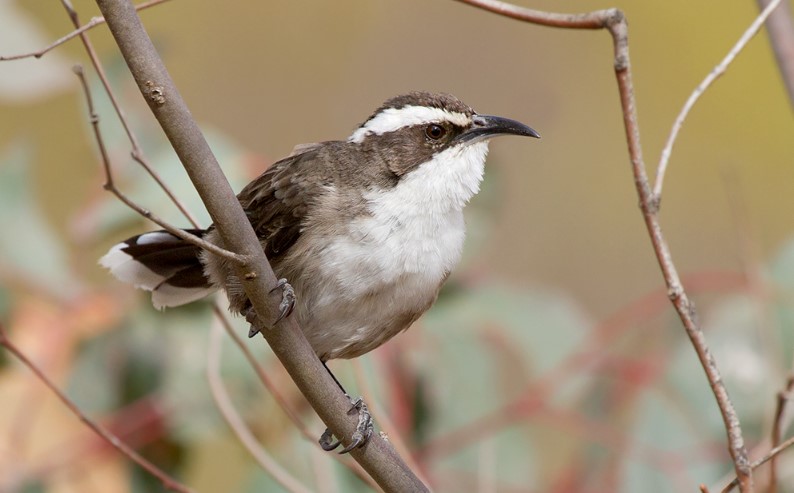Family: The white-browed babbler is a small, gregarious bird in the Pomatostomidae family.
Habitat: Even though it is smaller and more active than the Grey-crowned Babbler, the White-browed Babbler shares many of the same habits as the Grey-crowned Babbler.
Breeding pairs and their offspring live and breed in groups of up to 10 birds, which build their nests and feed the young together. Groups tend to stay sedentary year-round, defending territories of several hectares. Members of a group do the preening. Dormitory nests are used for roosting, and breeding nests are built separately. Foraging birds rummage through debris and probe nooks in the bark to find food, clucking softly as they bound along the ground and hop along branches to find prey.
Eating habits: White-browed babblers differ in their diet based on their environment and food sources. The majority of their diet consists of insects, spiders, amphibians, crustaceans, reptiles, fruit, seeds, and nuts, the most common varieties found on the ground where they spend most of their time. White-browed babblers spend more time foraging on the ground than gray-crowned babblers, but they can also work at tree terminals for insects, seeds, and spiders.
Flight: Each time one forager flies to the next patch of foraging cover, the others follow quickly behind. It flutters rapidly and flat glides with a narrow white terminal band while flying low and direct.

Alternative names: The other names are Happy Family, Kangaroo Bird, Stickbird, hopping Dick, Twelve Apostles, Yahoo, Go-Always, Jumper, and Chatterer.
Measurement: An adult white-browed babbler measures between 80 and 210 mm in length.
Identification: There is no difference between the sexes. There is a long, thin, white eyebrow with a dusky edge surrounding the dark brown-grey crown. Tail dusky with a broad white-tipped tip except for two white feathers at the center; back and wings brown-grey, shading into brown-black on the rump. White throat, breast, undertail, and flanks, grading to fawn on belly, flanks, and undertail. There is a brown tint to the eyes. With a pink-white base to the lower mandible, the long, thin, downward-curved bill is dusky in color. There is a dark gray color on the feet.
Immatures: For the first few months of their lives, fledglings have short bills, orange gaps, and rufous bends on their wings.
Related species: Since Hall’s babblers and white-browed babblers are similar in size, the two can be distinguished by comparing their superciliums.

Sound: There is a cacophony of chattering all year round from the white-browed babbler. Soft, repeated tuks are used for contact while feeding. There is a brisk, sharp whistle that signals the alarm. A fledgling squeals while begging and gives a rapid wake-up while sleeping.
Song: Short, rising whistles introduce White-browed Babbler’s song, a long-drawn miaow, which transitions into a down-slurred grinding churr and weet-weet miaow.
Nesting and Breeding: The breeding and nesting seasons are from July to December. The nests and dormitories are built with large twigs and lined with fine grass, wood, and feathers, similar to those of the Grey-crowned Babbler, but only 300–400 mm wide. Normally, nests are located in tree branches 1-6 meters above the ground, usually at a height of 2 meters.
Eggs: The bird lays a brown-gray egg with dark brown hairlines two or three times, sometimes even five times. Eggs measure about 24 x 17 mm and are oval in shape. It takes the female 16 days to incubate. During the three- or four-week nesting period, only one female generally lays the eggs, incubates them, and broods the chicks. It is common for there to be two broods per year. In order to feed nestlings, adults make soft ‘mewing’ sounds as they approach the nest.
Distribution: This bird grows in open forest, woodlands, mallee, and mulga scrub with shrubby sub-stages on the east to western slopes of the Great Dividing Range in Southern Australia. Studies have suggested that varying the number of these calls or the speed of them indicates varying levels of danger. There tends to be greater isolation between populations in central Australia and those near the coast.







